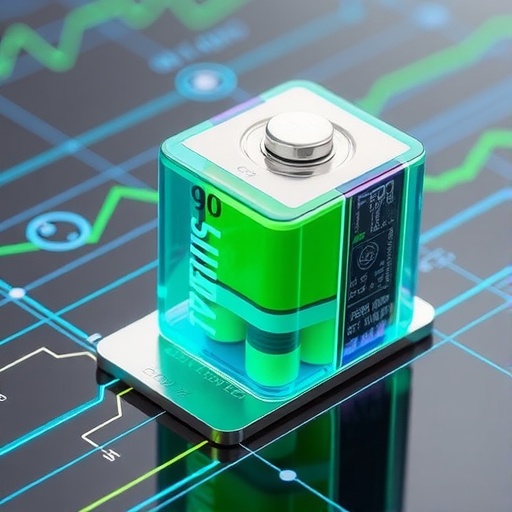In a groundbreaking development that promises significant advancements in the field of energy storage and management, researchers have unveiled an innovative model aimed at enhancing the predictive capabilities for the state-of-health (SOH) of lithium-ion batteries. This pioneering work, which integrates deep learning methodologies, particularly attention-based bidirectional Long Short-Term Memory (LSTM) networks, could well transform how energy professionals and manufacturers assess and optimize battery performance, thereby extending the lifespan and reliability of these critical energy storage systems.
Lithium-ion batteries have become an essential component in modern technology, powering everything from smartphones to electric vehicles. As the demand for reliable and efficient energy storage solutions continues to escalate, efficient monitoring and predictive maintenance of battery health have become paramount. A precise understanding of a battery’s state-of-health can preemptively address issues such as reduced capacity, overcharging, and premature failure, and this is where the new model developed by An, Ma, and Du stands to make considerable impacts.
The core of the researchers’ work is an attention-based bidirectional LSTM network, a type of recurrent neural network (RNN) specifically designed to capture temporal dependencies in sequential data. The bidirectional approach allows the model to learn from both past and future contexts, optimizing its accuracy in prediction tasks. The attention mechanism further enhances this by enabling the model to focus on significant features of the data, allowing it to weigh different input sequences more effectively, which results in improved predictive performance.
Data for training this sophisticated model has been meticulously gathered from real-world applications, ensuring that the results are both relevant and applicable. The researchers conducted extensive experiments with various configurations and datasets, revealing that the attention-based LSTM not only outperformed traditional statistical methods but also other machine learning techniques in predicting lithium-ion battery SOH. This is crucial because accurate SOH prediction can significantly disrupt current paradigms in battery management systems, allowing for more adaptive and predictive approaches.
By employing this advanced model, battery manufacturers can implement more effective monitoring solutions that can forecast potential failures well before they occur. This not only extends the asset lifespan but also optimizes the overall operational efficiency of battery-powered devices and systems. Consequently, the implications extend beyond individual devices, potentially influencing entire industries reliant on battery technologies, significantly reducing service delays and maintenance costs.
Another major contribution of this research is its potential to address concerns related to sustainability and environmental impact. Lithium-ion batteries, while prevalent, also pose disposal challenges due to their toxic components. Improved prediction of degradation rates and health management can lead to more informed decisions regarding recycling and end-of-life management of batteries, facilitating a circular economy in this tech-driven sector. By extending battery life, this model could assist in reducing waste, promoting sustainability, and contributing to more environmentally friendly energy solutions.
The researchers also emphasize the adaptability of their model. As battery chemistry evolves with advancements in technology, the LSTM’s architecture can be adjusted and retrained with new datasets, ensuring that the model remains relevant and accurate amidst rapid changes in the field. This adaptability is particularly crucial in today’s fast-paced technological landscape, where new battery materials and designs are continuously emerging.
Moreover, the implications of this research extend into the realm of smart cities and renewable energy integration. As the world pivots towards sustainable energy solutions, the role of energy storage, particularly via lithium-ion batteries, will become even more central. The ability to accurately forecast battery health will support efficient energy deployment strategies, enhancing grid reliability and allowing for the better integration of second-life applications for batteries that can no longer effectively serve their original purpose.
In light of these findings, it is clear that attention-based bidirectional LSTM models represent a significant leap forward in battery management research. As industries strive for efficiency and sustainability, innovative solutions such as this will play a pivotal role in driving adoption rates of renewable energy technologies, facilitating the transition towards more sustainable energy systems globally.
The researchers also call for collaboration between academia and industry to ensure that their findings are translated into practical applications. As researchers create models that push the boundaries of what’s possible, industry players must work synergistically to implement these innovations in real-world scenarios effectively.
The fundamental question remains: how can the insights derived from this advanced modeling technique influence the next generation of battery technologies? The promise of improved SOH prediction through sophisticated modeling techniques could signal seismic shifts in how industries manage energy resources, ensuring that lithium-ion batteries remain a cornerstone of modern energy storage solutions.
Much work lies ahead, but the potential is undeniably vast. As industries continue to demand improved efficiency and performance from lithium-ion technologies, attention-based LSTM models may become essential tools in achieving these goals.
In conclusion, this innovative research by An, Ma, and Du illuminates the path forward for enhanced battery health management and predictive maintenance solutions. By bridging theoretical advancements with practical applications, their findings encourage a deeper exploration of machine learning techniques in energy storage systems, shaping the future of battery technologies and their myriad applications.
Subject of Research: Lithium-ion battery state-of-health prediction through advanced modeling techniques.
Article Title: Attention-based bidirectional LSTM model construction and application for lithium-ion battery state-of-health prediction.
Article References:
An, Z., Ma, J., Du, X. et al. Attention-based bidirectional LSTM model construction and application for lithium-ion battery state-of-health prediction.
Ionics (2025). https://doi.org/10.1007/s11581-025-06678-3
Image Credits: AI Generated
DOI: https://doi.org/10.1007/s11581-025-06678-3
Keywords: Lithium-ion batteries, state-of-health prediction, attention-based LSTM, deep learning, energy storage, battery management systems, predictive maintenance, sustainability.
Tags: attention-based neural networksbattery lifespan extensionbidirectional LSTM applicationselectric vehicle battery managementenergy storage optimizationEnergy Storage Solutionslithium-ion battery health predictionLSTM deep learning modelmachine learning in energy systemspredictive maintenance of batteriesreducing battery failure risksstate-of-health monitoring





